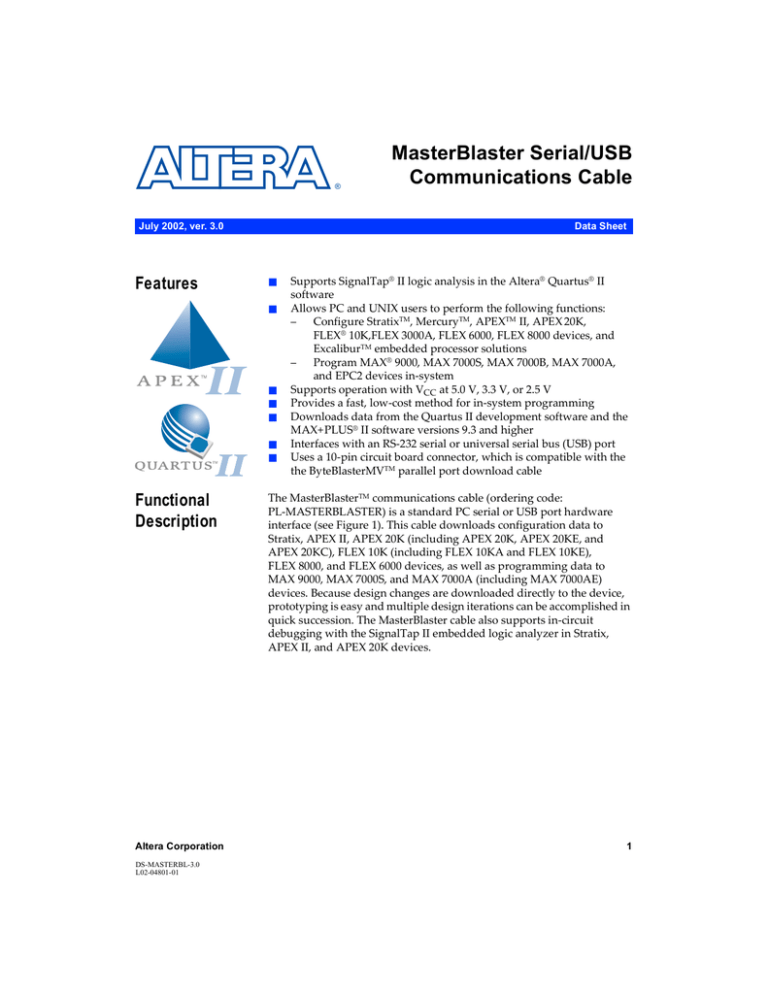
®
July 2002, ver. 3.0
Features
Data Sheet
■
■
■
■
■
■
■
Altera Corporation
DS-MASTERBL-3.0
L02-04801-01
Supports SignalTap® II logic analysis in the Altera® Quartus® II
software
Allows PC and UNIX users to perform the following functions:
–
Configure StratixTM, MercuryTM, APEXTM II, APEX 20K,
FLEX® 10K,FLEX 3000A, FLEX 6000, FLEX 8000 devices, and
ExcaliburTM embedded processor solutions
–
Program MAX® 9000, MAX 7000S, MAX 7000B, MAX 7000A,
and EPC2 devices in-system
Supports operation with VCC at 5.0 V, 3.3 V, or 2.5 V
Provides a fast, low-cost method for in-system programming
Downloads data from the Quartus II development software and the
MAX+PLUS® II software versions 9.3 and higher
Interfaces with an RS-232 serial or universal serial bus (USB) port
Uses a 10-pin circuit board connector, which is compatible with the
the ByteBlasterMVTM parallel port download cable
The MasterBlasterTM communications cable (ordering code:
PL-MASTERBLASTER) is a standard PC serial or USB port hardware
interface (see Figure 1). This cable downloads configuration data to
Stratix, APEX II, APEX 20K (including APEX 20K, APEX 20KE, and
APEX 20KC), FLEX 10K (including FLEX 10KA and FLEX 10KE),
FLEX 8000, and FLEX 6000 devices, as well as programming data to
MAX 9000, MAX 7000S, and MAX 7000A (including MAX 7000AE)
devices. Because design changes are downloaded directly to the device,
prototyping is easy and multiple design iterations can be accomplished in
quick succession. The MasterBlaster cable also supports in-circuit
debugging with the SignalTap II embedded logic analyzer in Stratix,
APEX II, and APEX 20K devices.
1
13
Development
Tools
Functional
Description
MasterBlaster Serial/USB
Communications Cable
MasterBlaster Serial/USB Communications Cable Data Sheet
Figure 1. MasterBlaster Serial/USB Communications Cable
Download Modes
The MasterBlaster cable provides two download modes:
■
■
Passive serial (PS) mode—Used for configuring APEX II, APEX 20K,
and FLEX devices
JTAG mode—Industry-standard IEEE Std. 1149.1 Joint Test Action
Group (JTAG) interface for programming JTAG-capable MAX and
serial configuration devices (i.e., EPC2) in-system or configuring
APEX II, APEX 20K, and FLEX devices
SignalTap II Logic Analysis
The SignalTap II logic analysis enables captured device data at specified
trigger points and stores the data in APEX II and APEX 20K embedded
system blocks (ESBs). This data is then sent to the JTAG IEEE Std. 1149.1
port of an APEX II or APEX 20K device, uploaded through the
MasterBlaster communications cable, and displayed in the Quartus II
Waveform Editor.
f
2
For more information on SignalTap logic analysis, see the AN 175:
SignalTap Analysis in the Quartus II Software.
Altera Corporation
MasterBlaster Serial/USB Communications Cable Data Sheet
MasterBlaster Connections
The MasterBlaster cable connects to a computer through a serial or USB
port, and connects to the circuit board through a standard 10-pin female
connector. Data is downloaded from the serial or USB port through the
MasterBlaster cable to the circuit board through the connections discussed
in this section.
Header & Plug Connections
The 9-pin male D-type connector connects to an RS-232 port with a
standard serial cable. See Table 1.
1
The USB connector can be used with any standard USB cable.
Table 1. MasterBlaster 9-Pin Serial D-Type Connector Pin-Outs
Pin
Signal Name
Description
rx
Receive data
tx
Transmit data
4
dtr
Data terminal ready
Signal ground
5
GND
6
dsr
Data set ready
7
rts
Request to send
8
cts
Clear to send
13
Development
Tools
2
3
For more information on 9-pin versus 25-pin serial connectors, search for
“9-pin or 25-pin serial connectors” in the Altera® solutions database at
http://www.altera.com.
The 10-pin female plug connects to a 10-pin male header on the circuit
board containing the target device(s). Figure 2 shows the dimensions of
the female plug.
LED Status
The purpose of the LED indicator lights located on the MasterBlaster
download cable is to provide information about the status of the
MasterBlaster cable. Table 2 lists the indicator and status of the
MasterBlaster cable.
Altera Corporation
3
MasterBlaster Serial/USB Communications Cable Data Sheet
Table 2. LED Status Indicator
Color
Blink Frequency
Description
Green
Slow
Cable ready
Green
Fast
Performing a logic analysis
Amber
Slow
Programming in progress
Figure 2. MasterBlaster 10-Pin Female Plug Dimensions
Dimensions are shown in inches. The spacing between pin centers is 0.1 inches.
0.425
0.425Typ.
Typ.
Color
ColorStrip
Strip
11
33
55
77
99
22
44
66
88
1010
0.250
0.250Typ.
Typ.
0.100
0.100Sq.
Sq.
0.025
0.025Sq.
Sq.
0.700
0.700Typ.
Typ.
Table 3 identifies the 10-pin female plug’s pin names for the
corresponding download mode.
4
Altera Corporation
MasterBlaster Serial/USB Communications Cable Data Sheet
Table 3. MasterBlaster Female Plug’s Pin Names & Download Modes
Pin
PS Mode
Signal Name
JTAG Mode
Description
Signal Name
Description
1
DCLK
Clock signal
TCK
Clock signal
2
GND
Signal ground
GND
Signal ground
3
CONF_DONE
Configuration control
TDO
Data from device
4
VCC
Power supply
VCC
Power supply
5
nCONFIG
Configuration control
TMS
JTAG state machine control
6
VIO
Reference voltage for
MasterBlaster output driver
VIO
Reference voltage for
MasterBlaster output driver
7
nSTATUS
Configuration status
–
No connect
8
–
No connect
–
No connect
9
DATA0
Data to device
TDI
Data to device
GND
Signal ground
GND
Signal ground
10
13
Powering the MasterBlaster Cable
■
■
■
5.0-V or 3.3-V circuit boards
DC power supply
5.0 V from the USB cable
When 5.0-V or 3.3-V power is not available on the circuit board, the
MasterBlaster cable can be powered by either DC power or the USB cable.
1
For the MasterBlaster cable’s output drivers, connect the circuit
board’s VCC and ground to the MasterBlaster cable’s VCC, VIO,
and GND pins.
Circuit Board Header Connection
The MasterBlaster cable’s 10-pin female plug connects to a 10-pin male
header on the circuit board. The 10-pin male header has two rows of five
pins, which are connected to the device’s programming or configuration
pins. Figure 3 shows the dimensions of a typical 10-pin male header.
Altera Corporation
5
Development
Tools
Older download cables received their power from the circuit board only.
In contrast, the MasterBlaster cable can receive power from the following
sources:
MasterBlaster Serial/USB Communications Cable Data Sheet
Figure 3. 10-Pin Male Header Dimensions
Dimensions are shown in inches.
Top View
Side View
0.100
0.025 Sq.
0.100
0.235
Operating
Conditions
Tables 4 through 6 summarize the absolute maximum ratings,
recommended operating conditions, and DC operating conditions for the
MasterBlaster cable.
Table 4. MasterBlaster Cable Absolute Maximum Ratings
Conditions
Min
Max
Unit
VCC
Symbol
Supply voltage
Parameter
With respect to ground
–0.5
7.0
V
VI
DC input voltage
With respect to ground
–0.5
7.0
V
Min
Max
Unit
Board header supply
voltage, 5.0-V operation
4.5
5.5
V
Board header supply
voltage, 3.3-V operation
3.0
3.6
V
Min
Max
Unit
Table 5. MasterBlaster Cable Recommended Operating Conditions
Symbol
VCC
Parameter
Conditions
Table 6. MasterBlaster Cable DC Operating Conditions
Symbol
Parameter
Conditions
VIH
High-level input voltage
VCC = VIO
VIL
Low-level input voltage
VCC = VIO
6
Notes (1), (2)
(Part 1 of 2)
0.25 × VIO + 0.3 V
V
0.25 × VIO
V
Altera Corporation
MasterBlaster Serial/USB Communications Cable Data Sheet
Table 6. MasterBlaster Cable DC Operating Conditions
Symbol
VOH
VOL
Conditions
Min
Max
Unit
5.0-V high-level TTL
output voltage
TTL load. VCC = VIO = 4.5 V,
IOH = 8 mA
3.2
V
3.3-V high-level TTL
output voltage
TTL load. VCC = VIO = 3.0 V,
IOH = 4 mA
2.4
V
5.0-V high-level CMOS
output voltage
CMOS load. VCC = VIO = 4.5 V,
IOH = 0.1 mA
4.0
V
3.3-V high-level CMOS
output voltage
CMOS load. VCC = VIO = 3.0 V,
IOH = 0.1 mA
2.7
V
2.5-V high-level CMOS
output voltage
CMOS load. VCC = VIO = 2.3 V,
IOH = 0.1 mA
2.0
V
5.0-V low-level TTL output
voltage
TTL load. VCC = VIO = 4.5 V,
IOL = 8 mA
0.4
V
3.3-V low-level TTL output
voltage
TTL load. VCC = VIO = 3.0 V,
IOL = 4 mA
0.4
V
5.0-V low-level CMOS
output voltage
CMOS load. VCC = VIO = 4.5 V,
IOL = 0.1 mA
0.1
V
3.3-V low-level CMOS
output voltage
CMOS load. VCC = VIO = 3.0 V,
IOL = 0.1 mA
0.1
V
2.5-V low-level CMOS
output voltage
CMOS load. VCC = VIO = 2.3 V,
IOL = 0.1 mA
0.1
V
1.0
W
Operating power
13
Development
Tools
P
Parameter
(Part 2 of 2)
Notes to tables:
(1)
(2)
The DC adapter supply voltage has a minimum value of 3.0 V, a maximum value of 16.0 V, and a power
consumption of 1 W (VCC can be at 5.0 V, 3.3 V, or 2.5 V).
The 5.0-V USB cable supply voltage has a minimum value of 4.5 V and a maximum value of 5.5 V (VCC can be at
5.0 V, 3.3 V, or 2.5 V).
References
For more information on configuration and in-system programmability
(ISP), see the following sources:
■
■
■
■
■
■
■
■
■
■
Altera Corporation
Application Note 116 (Configuring APEX 20K, FLEX 10K & FLEX 6000
Devices)
Application Note 33 (Configuring FLEX 8000 Devices)
Application Note 38 (Configuring Multiple FLEX 8000 Devices)
Application Note 39 (IEEE 1149.1 (JTAG) Boundary-Scan Testing in
Altera Devices)
Application Note 95 (In-System Programmability in MAX Devices)
Application Note 100 (In-System Programmability Guidelines)
APEX 20K Programmable Logic Device Family Data Sheet
FLEX 10K Embedded Programmable Logic Family Data Sheet
FLEX 8000 Programmable Logic Device Family Data Sheet
FLEX 6000 Programmable Logic Device Family Data Sheet
7
MasterBlaster Serial/USB Communications Cable Data Sheet
■
■
■
■
■
101 Innovation Drive
San Jose, CA 95134
(408) 544-7000
http://www.altera.com
Applications Hotline:
(800) 800-EPLD
Literature Services:
lit_req@altera.com
8
MAX 9000 Programmable Logic Device Family Data Sheet
MAX 7000 Programmable Logic Device Family Data Sheet
MAX 7000A Programmable Logic Device Family Data Sheet
Search for “Configuring a Single Device with the BitBlasterTM,
ByteBlaster, or FLEX Download Cable,” “Setting Up Multi-Device
JTAG Chains,” “Configuring Multiple Devices in a JTAG Chain with
the BitBlaster or ByteBlasterMV,” and “Programming Multiple
Devices in a JTAG Chain with the BitBlaster or ByteBlasterMV” in the
MAX+PLUS II Help menu.
The Quartus Installation & Licensing manual for information on how
to install the MasterBlaster cable.
Copyright © 2002 Altera Corporation. All rights reserved. Altera, The Programmable Solutions Company, the
stylized Altera logo, specific device designations, and all other words and logos that are identified as
trademarks and/or service marks are, unless noted otherwise, the trademarks and service marks of Altera
Corporation in the U.S. and other countries. All other product or service names are the property of their
respective holders. ARM is a registered trademark of ARM Limited. ModelSim and Mentor Graphics are
registered trademarks and LeonardoSpectrum, Exemplar Logic, and Model Technology are trademarks of
Mentor Graphics Corporation. Altera products are protected under numerous U.S. and foreign patents and
pending applications, maskwork rights, and copyrights. Altera warrants performance of
its semiconductor products to current specifications in accordance with Altera's standard
warranty, but reserves the right to make changes to any products and services at any time
without notice. Altera assumes no responsibility or liability arising out of the application
or use of any information, product, or service described herein except as expressly agreed
to in writing by Altera Corporation. Altera customers are advised to obtain the latest
version of device specifications before relying on any published information and before
placing orders for products or services.
Altera Corporation
Printed on Recycled Paper.



